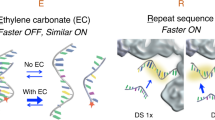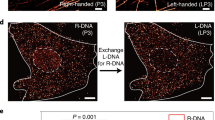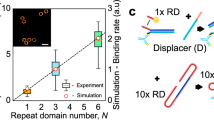Abstract
DNA-based points accumulation for imaging in nanoscale topography (DNA-PAINT) is a powerful super-resolution microscopy method that can acquire high-fidelity images at nanometer resolution. It suffers, however, from high background and slow imaging speed, both of which can be attributed to the presence of unbound fluorophores in solution. Here we present two-color fluorogenic DNA-PAINT, which uses improved imager probe and docking strand designs to solve these problems. These self-quenching single-stranded DNA probes are conjugated with a fluorophore and quencher at the terminals, which permits an increase in fluorescence by up to 57-fold upon binding and unquenching. In addition, the engineering of base pair mismatches between the fluorogenic imager probes and docking strands allowed us to achieve both high fluorogenicity and the fast binding kinetics required for fast imaging. We demonstrate a 26-fold increase in imaging speed over regular DNA-PAINT and show that our new implementation enables three-dimensional super-resolution DNA-PAINT imaging without optical sectioning.
This is a preview of subscription content, access via your institution
Access options
Access Nature and 54 other Nature Portfolio journals
Get Nature+, our best-value online-access subscription
$29.99 / 30 days
cancel any time
Subscribe to this journal
Receive 12 print issues and online access
$259.00 per year
only $21.58 per issue
Buy this article
- Purchase on Springer Link
- Instant access to full article PDF
Prices may be subject to local taxes which are calculated during checkout





Similar content being viewed by others
Data availability
The majority of datasets generated during and/or analyzed during the current study are available at the Zenodo repository (https://doi.org/10.5281/zenodo.6315337). Remaining raw datasets are available from the corresponding author on reasonable request.
Code availability
PYME is available at https://python-microscopy.org/. The PYME modules that we have developed are shared at https://github.com/bewersdorflab. Codes for simulating multi-emitters (Supplementary Fig. 2) and for screening docking strands (Supplementary Note 3) are available at the GitHub repository (https://github.com/bewersdorflab/fluorogenic-dna-paint-manuscript-supplement).
References
Baddeley, D. & Bewersdorf, J. Biological insight from super-resolution microscopy: what we can learn from localization-based images. Annu. Rev. Biochem. 87, 965–989 (2018).
Jungmann, R. et al. Single-molecule kinetics and super-resolution microscopy by fluorescence imaging of transient binding on DNA origami. Nano Lett. 10, 4756–4761 (2010).
Agasti, S. S. et al. DNA-barcoded labeling probes for highly multiplexed Exchange-PAINT imaging. Chem. Sci. 8, 3080–3091 (2017).
Beliveau, B. J. et al. Single-molecule super-resolution imaging of chromosomes and in situ haplotype visualization using Oligopaint FISH probes. Nat. Commun. 6, 7147 (2015).
Jungmann, R. et al. Quantitative super-resolution imaging with qPAINT. Nat. Methods 13, 439–442 (2016).
Dempsey, G. T., Vaughan, J. C., Chen, K. H., Bates, M. & Zhuang, X. Evaluation of fluorophores for optimal performance in localization-based super-resolution imaging. Nat. Methods 8, 1027–1036 (2011).
Jungmann, R. et al. Multiplexed 3D cellular super-resolution imaging with DNA-PAINT and Exchange-PAINT. Nat. Methods 11, 313–318 (2014).
Liu, N., Dai, M., Saka, S. K. & Yin, P. Super-resolution labelling with Action-PAINT. Nat. Chem. 11, 1001–1008 (2019).
Schlichthaerle, T. et al. Direct visualization of single nuclear pore complex proteins using genetically-encoded probes for DNA-PAINT. Angew. Chem. Int. Ed. Engl. 58, 13004–13008 (2019).
Schnitzbauer, J., Strauss, M. T., Schlichthaerle, T., Schueder, F. & Jungmann, R. Super-resolution microscopy with DNA-PAINT. Nat. Protoc. 12, 1198–1228 (2017).
Schueder, F. et al. Multiplexed 3D super-resolution imaging of whole cells using spinning disk confocal microscopy and DNA-PAINT. Nat. Commun. 8, 2090 (2017).
Schueder, F. et al. An order of magnitude faster DNA-PAINT imaging by optimized sequence design and buffer conditions. Nat. Methods 16, 1101–1104 (2019).
Filius, M. et al. High-speed super-resolution imaging using protein-assisted DNA-PAINT. Nano Lett. 20, 2264–2270 (2020).
Lee, J., Park, S., Kang, W. & Hohng, S. Accelerated super-resolution imaging with FRET-PAINT. Mol. Brain 10, 63 (2017).
Lee, J., Park, S. & Hohng, S. Accelerated FRET-PAINT microscopy. Mol. Brain 11, 70 (2018).
Auer, A., Strauss, M. T., Schlichthaerle, T. & Jungmann, R. Fast, background-free DNA-PAINT imaging using FRET-based probes. Nano Lett. 17, 6428–6434 (2017).
Tyagi, S. & Kramer, F. R. Molecular beacons: probes that fluoresce upon hybridization. Nat. Biotechnol. 14, 303–308 (1996).
Tsourkas, A., Behlke, M. A., Rose, S. D. & Bao, G. Hybridization kinetics and thermodynamics of molecular beacons. Nucleic Acids Res. 31, 1319–1330 (2003).
Clegg, R. M., Murchie, A. I., Zechel, A. & Lilley, D. M. Observing the helical geometry of double-stranded DNA in solution by fluorescence resonance energy transfer. Proc. Natl Acad. Sci. USA 90, 2994–2998 (1993).
Cock, P. J. et al. Biopython: freely available Python tools for computational molecular biology and bioinformatics. Bioinformatics 25, 1422–1423 (2009).
Zadeh, J. N. et al. NUPACK: analysis and design of nucleic acid systems. J. Comput. Chem. 32, 170–173 (2011).
Fisher, P. D. E. et al. A programmable DNA origami platform for organizing intrinsically disordered nucleoporins within nanopore confinement. ACS Nano 12, 1508–1518 (2018).
Li, Y. et al. Real-time 3D single-molecule localization using experimental point spread functions. Nat. Methods 15, 367–369 (2018).
Huang, F. et al. Ultra-high resolution 3D imaging of whole cells. Cell 166, 1028–1040 (2016).
Zhang, Y. et al. Nanoscale subcellular architecture revealed by multicolor three-dimensional salvaged fluorescence imaging. Nat. Methods 17, 225–231 (2020).
Malkusch, S. et al. Coordinate-based colocalization analysis of single-molecule localization microscopy data. Histochem. Cell Biol. 137, 1–10 (2012).
Wade, O. K. et al. 124-color super-resolution imaging by engineering DNA-PAINT blinking kinetics. Nano Lett. 19, 2641–2646 (2019).
Strauss, S. & Jungmann, R. Up to 100-fold speed-up and multiplexing in optimized DNA-PAINT. Nat. Methods 17, 789–791 (2020).
Clowsley, A. H. et al. Repeat DNA-PAINT suppresses background and non-specific signals in optical nanoscopy. Nat. Commun. 12, 501 (2021).
Stahl, E., Martin, T. G., Praetorius, F. & Dietz, H. Facile and scalable preparation of pure and dense DNA origami solutions. Angew. Chem. Int. Ed. Engl. 53, 12735–12740 (2014).
Lin, C., Perrault, S. D., Kwak, M., Graf, F. & Shih, W. M. Purification of DNA-origami nanostructures by rate-zonal centrifugation. Nucleic Acids Res. 41, e40 (2013).
Nemoto, Y. & De Camilli, P. Recruitment of an alternatively spliced form of synaptojanin 2 to mitochondria by the interaction with the PDZ domain of a mitochondrial outer membrane protein. EMBO J. 18, 2991–3006 (1999).
McGorty, R., Kamiyama, D. & Huang, B. Active microscope stabilization in three dimensions using image correlation. Opt. Nanoscopy 2, 3 (2013).
Takakura, H. et al. Long time-lapse nanoscopy with spontaneously blinking membrane probes. Nat. Biotechnol. 35, 773–780 (2017).
Tyson, J. et al. Extremely bright, near-IR emitting spontaneously blinking fluorophores enable ratiometric multicolor nanoscopy in live cells. ACS Cent. Sci. 7, 1419–1426 (2021).
Marin, Z. et al. PYMEVisualize: an open-source tool for exploring 3D super-resolution data. Nat. Methods 18, 582–584 (2021).
Lin, R., Clowsley, A. H., Jayasinghe, I. D., Baddeley, D. & Soeller, C. Algorithmic corrections for localization microscopy with sCMOS cameras—characterisation of a computationally efficient localization approach. Opt. Express 25, 11701–11716 (2017).
Baddeley, D., Jayasinghe, I. D., Cremer, C., Cannell, M. B. & Soeller, C. Light-induced dark states of organic fluochromes enable 30 nm resolution imaging in standard media. Biophys. J. 96, L22–L24 (2009).
Baddeley, D. et al. 4D super-resolution microscopy with conventional fluorophores and single wavelength excitation in optically thick cells and tissues. PLoS ONE 6, e20645 (2011).
Wang, Y. et al. Localization events-based sample drift correction for localization microscopy with redundant cross-correlation algorithm. Opt. Express 22, 15982–15991 (2014).
Nieuwenhuizen, R. P. et al. Measuring image resolution in optical nanoscopy. Nat. Methods 10, 557–562 (2013).
Malkusch, S. & Heilemann, M. Extracting quantitative information from single-molecule super-resolution imaging data with LAMA—LocAlization Microscopy Analyzer. Sci. Rep. 6, 34486 (2016).
Virtanen, P. et al. SciPy 1.0: fundamental algorithms for scientific computing in Python. Nat. Methods 17, 261–272 (2020).
Acknowledgements
We thank L. Fuentes, K. Hu, Z. Marin and F. Schueder for helpful discussions. This work was primarily supported by a 4D Nucleome grant from the National Institutes of Health (NIH; U01 DA047734 to J.B. and D.B.) and the Wellcome Trust (203285/B/16/Z). J.B. acknowledges support from NIH grant P30 DK045735 (to R. Sherwin). C.L. acknowledges support from an NIH Director’s New Innovator award (GM114830), an NIH grant (GM132114) and Yale University faculty startup funding. N.D.W. was supported by an NIH training grant (T32 EB019941).
Author information
Authors and Affiliations
Contributions
K.K.H.C. and J.B. conceived the idea. Z.Z. designed the DNA origami structure. Z.Z., N.D.W. and Y.Y. prepared DNA origami samples. P.K. prepared cell samples. K.K.H.C. and Y.Z. imaged samples and generated the localization data. K.K.H.C. and B.R. performed additional data analyses. K.K.H.C. derived the blinking model and performed simulations. J.B., C.L. and D.B. supervised the project. K.K.H.C. and J.B. wrote the manuscript with input from all authors.
Corresponding author
Ethics declarations
Competing interests
J.B. discloses financial interest in Bruker, Hamamatsu Photonics and panluminate. J.B. is co-inventor on a US patent (9,769,399) related to the 4Pi-SMS system and image analysis used in this work. Y.Z. and J.B. are co-inventors on a US patent (11,209,367) related to 4Pi-SMS microscopy. The remaining authors declare no competing interests.
Peer review
Peer review information
Nature Methods thanks Matthew Baker and the other, anonymous, reviewer(s) for their contribution to the peer review of this work. Rita Strack was the primary editor on this article and managed its editorial process and peer review in collaboration with the rest of the editorial team.
Additional information
Publisher’s note Springer Nature remains neutral with regard to jurisdictional claims in published maps and institutional affiliations.
Extended data
Extended Data Fig. 1
List of imager probes and docking strands used in this study.
Extended Data Fig. 2 Alignment between imager probes and their corresponding docking strands.
Fluorogenic DNA-PAINT uses imager probes and docking strands with internal mismatches. Complementary base pairings are colored in blue whereas mismatches in red.
Extended Data Fig. 3 Fast astigmatic 3D fluorogenic DNA-PAINT imaging without optical sectioning.
The full dataset from which Fig. 4a-c were generated. (a) Fast 3D fluorogenic DNA-PAINT imaging of immunolabeled microtubules in COS-7 cells under widefield illumination at multiple time points. A reasonable image can be acquired in 30 s. (b) Bleaching is negligible, causing only a small reduction (30%) in blinking rate over an hour. (c) 3D resolution as quantified by Fourier shell correlation (FSC) improves with longer imaging duration as more blinking events are detected. The resolution reaches 34.3 nm after 1 hr. (d) The localization precision peaks at < 5 nm for all three dimensions (X: 1.7 nm, Y: 1.7 nm, Z: 4.5 nm). (e) Fitting an exponential decay function to blink durations (blinks that are only 1 frame in duration were ignored for fitting) estimates the mean off-rate at 46.7 s-1.
Extended Data Fig. 4 Time series of fast 2-color fluorogenic DNA-PAINT imaging without optical sectioning.
The full dataset from which Fig. 5b-f were generated, rendered at various timepoints. (a-d) Fast 2-color fluorogenic DNA-PAINT imaging of immunolabeled endoplasmic reticulum (ii; [imager probe A] = 10 nM) and mitochondria (iii; [imager probe B] = 1 nM) in U-2 OS cells under widefield illumination (100 Hz frame rate). There is no well-defined minimum imaging time as it depends on a multitude of factors including the biological question being addressed. The timepoint we reported in the main text (600 s) is more densely sampled than typical single-molecule localization microscopy images. Negligible changes are observed with prolonged imaging (d; 1,200 s) which would suggest oversampling.
Extended Data Fig. 5 Analysis of fast 2-color fluorogenic DNA-PAINT imaging without optical sectioning.
Detailed analysis of the full 20-minute 2-color fluorogenic DNA-PAINT dataset from which Fig. 5 and Extended Data Fig. 4 were generated. Image colored by the correlation parameter (C) based on Coordinate-Based Colocalization (CBC) analysis at low (a) and high (b) magnification. (c) Histogram of the correlation parameter, C. A value of zero indicates a lack of correlation between the two color channels (C = -0.09 ± 0.30; nblink = 2,322,207; two-sided one-sample Wilcoxon signed-rank test against zero, T-statistic=9×1011, p < 0.001). (d) Minimal bleaching is observed over a 20-minute timeframe (~20%). (e) The lateral localization precision peaks at < 5 nm for both channels. (f) Blink durations fitted with an exponential decay function to estimate the binding off-rate (blinks that are only 1 frame in duration were ignored for fitting).
Extended Data Fig. 6 Additional examples of fast 2-color fluorogenic DNA-PAINT imaging without optical sectioning.
Fast 2-color fluorogenic DNA-PAINT imaging of immunolabeled endoplasmic reticulum (green; [imager probe A] = 10 nM) and mitochondria (magenta; [imager probe B] = 1 nM) in U-2 OS cells under widefield illumination (100 Hz frame rate for 10 minutes) (n = 5 including the dataset presented in detail in Fig. 5 and Extended Data Figs. 4,5).
Supplementary information
Supplementary Information
Supplementary Notes 1–3, Tables 1–4 and Figs. 1–3.
Supplementary Video 1
Fast 3D fluorogenic DNA-PAINT imaging (imager probe A concentration = 10 nM, 100 Hz, 10 min) of microtubules in a COS-7 cell without optical sectioning under widefield illumination. The hollow center of microtubules can be observed in both the xy and xz planes when viewing 30-nm-thick cross-sections. Scale bar, 1 µm.
Supplementary Video 2
a, Raw images from fast astigmatic 3D fluorogenic DNA-PAINT imaging (imager probe A concentration = 10 nM, 100 Hz) of microtubules in a COS-7 cell under widefield illumination. b, Live kymograph of the blinking within the dashed box in a.
Supplementary Video 3
a, Images from fast two-color fluorogenic DNA-PAINT using imager probe A (10 nM, Cy3B, green) and imager probe B (1 nM, ATTO 643, magenta) to image the endoplasmic reticulum and mitochondria, respectively (100 Hz; raw images from the two-color channels were transformed and aligned for display). b, Heatmap of pixel intensities. Negligible spectral cross-talk between the fluorophores (Cy3B and ATTO 643) was observed as indicated by the well-resolved populations (green and magenta dashed lines, respectively).
Rights and permissions
About this article
Cite this article
Chung, K.K.H., Zhang, Z., Kidd, P. et al. Fluorogenic DNA-PAINT for faster, low-background super-resolution imaging. Nat Methods 19, 554–559 (2022). https://doi.org/10.1038/s41592-022-01464-9
Received:
Accepted:
Published:
Issue Date:
DOI: https://doi.org/10.1038/s41592-022-01464-9
This article is cited by
-
Dual-color DNA-PAINT single-particle tracking enables extended studies of membrane protein interactions
Nature Communications (2023)
-
Combining pMINFLUX, graphene energy transfer and DNA-PAINT for nanometer precise 3D super-resolution microscopy
Light: Science & Applications (2023)
-
Scanning single molecule localization microscopy (scanSMLM) for super-resolution volume imaging
Communications Biology (2023)



